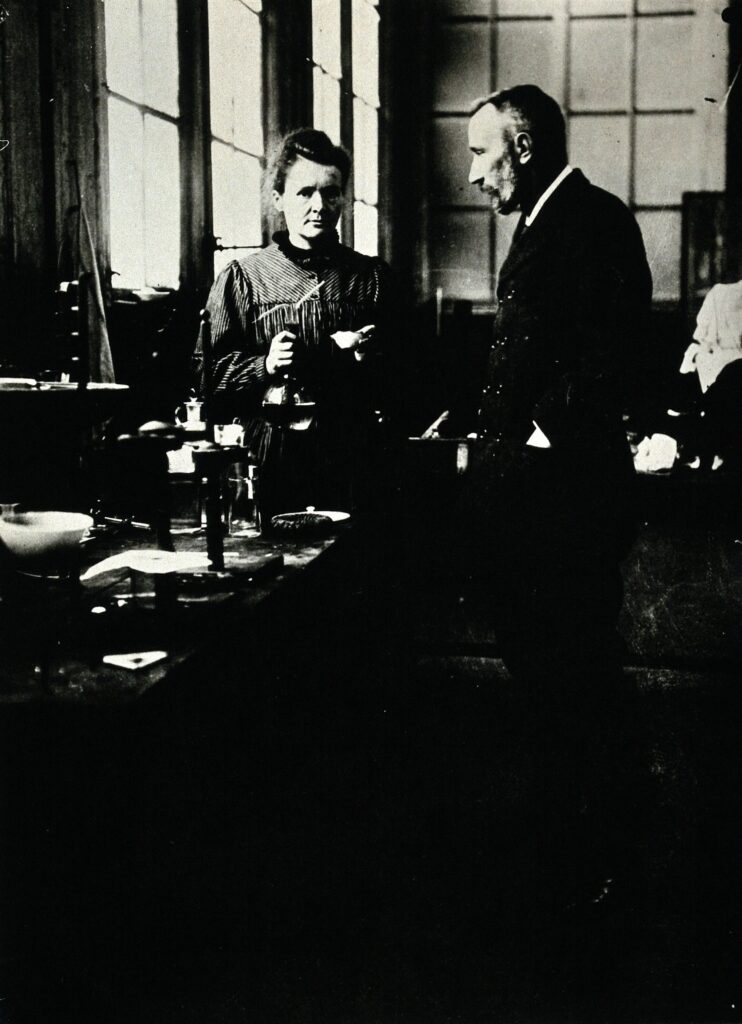It was one of those ‘archaic’ experiments in the Natural Philosophy laboratory at Glasgow University. It had been included in the belief that it provided the student with a better appreciation of the basics of radioactivity. As I recall the experiment involved a radioactive source and a gold leaf electroscope. When a charge was placed on the upper disc of the electroscope this caused the twin gold leaf elements to diverge. A specific angle between the elements was a measure of the charge held in the system. Any radioactivity causing ionisation in the chamber would result in a reduction of the angle of separation of the two gold leaf elements. Although exact details of the experiment are hazy, a key aspect was the notion that the source had been obtained by Professor Dee at some time from no less than Madam Curie. Professor Dee had been responsible for structuring the specific student experiment. I recall mentioning the matter at the time to an Australian post graduate researcher in the department in Glasgow whose key interest was nuclear fusion. He had expressed the opinion that there were more modern methods to demonstrate the basic laws of radioactivity, perhaps with the use of Geiger-Muller detectors.
The Curies had been acclaimed for the discovery of the radioactive elements Polonium and Radium. Most accounts indicate that the original Polonium isotope discovered by the Curies was Po-210 with a half life of 128 days based on the decay chain of Radium-226. This specific Polonium isotope is identified as especially dangerous if ingested, since even a tiny amount could deliver a fatal dose of radioactivity to internal organs. Also, the half life of the Po-210 isotope is 138 days and the expected level of activity from the isotope after around 80 half lives based on original isotope supply possibly around 1930 would be entirely undetectable. The source used in the experiment is therefore unlikely to have been based on Po-210.
The original traces of Polonium in the Pitchblende ore obtained from Austria had been laboriously dissolved in acid by Marie Curie as a decay product of Uranium Oxide. Polonium, however, was commonly used in the 1920’s and 1930’s as a source of alpha particles. There is documentation to indicate that the Polonium sources at the Cavendish were prepared from a dilution of Ra-226 where it was assumed that Po-210 was deposited on a disk of silver from the solution presumably by an electroplating method. There is in fact some documentation to indicate that Philip Dee had used Polonium sources while active at the Cavendish Laboratory in Cambridge in the 1920’s and 1930’s. James Chadwick had used a Polonium source in his famous experiments at the Cavendish relating to the discovery of the neutron which was announced in 1932. The source of the Polonium used at the Cavendish for Chadwick’s experiment however becomes more clear when a brief reference to Norman Feather in Chadwick’s paper on the discovery of the neutron is followed up more closely and using more modern sources. Feather had spent a year in America and had become aware that at the Kelly Hospital in Baltimore a five gram Radium source was used as a source of the Radioactive gas Radon for cancer treatment. The method used was unconventional where large doses were collected in a single glass vial rather than in multiple smaller doses. A decay product of the ‘spent” vials was Po-210 which could be recovered by crushing the glass vials and dissolving the Po-210 in Nitric Acid. Feather was able initially to provide the Cavendish with around 300 such vials which he brought back from America which allowed a highly active Po-210 source to be produced for Chadwick’s work. After the successful discovery of the neutron in 1932, Feather then back in England, successfully obtained an additional batch of vials from the Kelly Hospital. Without such an active source of Po-210, Chadwick’s discovery of the neutron would gave been a much greater challenge.
For several years Rutherford had been keen to promote research to prove the existence of the neutron he had earlier anticipated and Philip Dee had spent a frustrating time in the lead up to Chadwick’s discovery trying to detect neutron-electron scattering events. The cross section of such events, however, was too small to be observed even with the high quality cloud chamber technology Philip Dee had developed. Such technology, however, was to prove invaluable in demonstrating many of the key nuclear reactions discovered at the Cavendish.
As undergraduate ‘Physics’ students we had no appreciation of the other eminent scientific colleagues that Professor Dee had worked alongside at the Cavendish and which had included individuals such as Earnst Rutherford and Nobel Laureate CTR Wilson. Also, the rigorous safety protocols that are now in place regarding the handling and management of radioactive sources were largely absent in this era. In a late career interview Professor Dee recalled that there was one technician at the Cavendish who could discharge a gold leaf electroscope just by breathing on it. Apparently Sir Earnst Rutherford thought this was highly amusing and was not duly concerned.
So it slightly unlikely that I did indeed conduct that experiment courtesy of a radioactive source Marie Curie had supplied, although if course it was her early pioneering work that had made future discoveries possible.

As a postscript, subsequent investigation of Professor Dee’s war time legacy was to reveal his key role in the development of aircraft based radar technology for U-boat detection. This was one of the key elements that was to finally win the War of the Atlantic for the Allies.